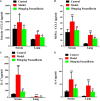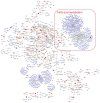Integration of Metabolomics and Transcriptomics Reveals the Therapeutic Mechanism Underlying Paeoniflorin for the Treatment of Allergic Asthma
- PMID: 30761008
- PMCID: PMC6362974
- DOI: 10.3389/fphar.2018.01531
Integration of Metabolomics and Transcriptomics Reveals the Therapeutic Mechanism Underlying Paeoniflorin for the Treatment of Allergic Asthma
Abstract
Objectives: Asthma is a chronic airway inflammatory disease, which is characterized by airway remodeling, hyperreactivity and shortness of breath. Paeoniflorin is one of the major active ingredients in Chinese peony, which exerts anti-inflammatory and immune-regulatory effects in multiple diseases. However, it remains unclear whether paeoniflorin treatment can suppress allergic asthma. Methods: In this study, we evaluated the effect of paeoniflorin on lung function and airway inflammation in asthmatic mice. These asthmatic Balb/c mice were first sensitized and constructed through ovalbumin (OVA) motivation. Subsequently, we determined the mechanism of action of paeoniflorin in treating allergic asthma through integrated transcriptomic and metabolomic data sets. Results: Our results demonstrated that many genes and metabolites were regulated in the paeoniflorin-treated mice. Moreover, the potential target proteins of paeoniflorin played important roles in fatty acid metabolism, inflammatory response, oxidative stress and local adhesion. Conclusion: Paeoniflorin has a beneficial effect on asthma, which may be achieved through regulating fatty acid metabolism, inflammatory response and the adhesion pathway at system level.
Keywords: allergic asthma; fatty acid metabolism; metabolomics; paeoniflorin; transcriptomics.
Figures







Similar articles
-
Paeoniflorin attenuates allergic inflammation in asthmatic mice.Int Immunopharmacol. 2015 Jan;24(1):88-94. doi: 10.1016/j.intimp.2014.11.016. Epub 2014 Nov 26. Int Immunopharmacol. 2015. PMID: 25433342
-
Immunoregulatory Effects of Paeoniflorin Exerts Anti-asthmatic Effects via Modulation of the Th1/Th2 Equilibrium.Inflammation. 2015 Dec;38(6):2017-25. doi: 10.1007/s10753-015-0182-5. Inflammation. 2015. PMID: 25971794
-
Protective effects and active ingredients of Salvia miltiorrhiza Bunge extracts on airway responsiveness, inflammation and remodeling in mice with ovalbumin-induced allergic asthma.Phytomedicine. 2019 Jan;52:168-177. doi: 10.1016/j.phymed.2018.09.170. Epub 2018 Sep 17. Phytomedicine. 2019. PMID: 30599896
-
Protective effects of paeoniflorin on cardiovascular diseases: A pharmacological and mechanistic overview.Front Pharmacol. 2023 May 30;14:1122969. doi: 10.3389/fphar.2023.1122969. eCollection 2023. Front Pharmacol. 2023. PMID: 37324475 Free PMC article. Review.
-
Paeoniflorin: a review of its pharmacology, pharmacokinetics and toxicity in diabetes.Front Pharmacol. 2025 Apr 7;16:1551368. doi: 10.3389/fphar.2025.1551368. eCollection 2025. Front Pharmacol. 2025. PMID: 40260393 Free PMC article. Review.
Cited by
-
Immune Metabolism in TH2 Responses: New Opportunities to Improve Allergy Treatment - Cell Type-Specific Findings (Part 2).Curr Allergy Asthma Rep. 2023 Jan;23(1):41-52. doi: 10.1007/s11882-022-01058-7. Epub 2022 Dec 15. Curr Allergy Asthma Rep. 2023. PMID: 36520269 Free PMC article. Review.
-
Drug Candidates for Autoimmune Diseases.Pharmaceuticals (Basel). 2022 Apr 20;15(5):503. doi: 10.3390/ph15050503. Pharmaceuticals (Basel). 2022. PMID: 35631330 Free PMC article. Review.
-
Effect of You-Gui-Wan on House Dust Mite-Induced Mouse Allergic Asthma via Regulating Amino Acid Metabolic Disorder and Gut Dysbiosis.Biomolecules. 2021 May 30;11(6):812. doi: 10.3390/biom11060812. Biomolecules. 2021. PMID: 34070764 Free PMC article.
-
UVA Induced Oxidative Stress Was Inhibited by Paeoniflorin/Nrf2 Signaling or PLIN2.Front Pharmacol. 2020 May 15;11:736. doi: 10.3389/fphar.2020.00736. eCollection 2020. Front Pharmacol. 2020. PMID: 32499710 Free PMC article.
-
Circadian Pharmacological Effects of Paeoniflorin on Mice With Urticaria-like Lesions.Front Pharmacol. 2022 Feb 9;12:639580. doi: 10.3389/fphar.2021.639580. eCollection 2021. Front Pharmacol. 2022. PMID: 35222003 Free PMC article.
References
-
- Chen J., Zhang M., Zhu M., Gu J., Song J., Cui L., et al. (2018). Paeoniflorin prevents endoplasmic reticulum stress-associated inflammation in lipopolysaccharide-stimulated human umbilical vein endothelial cells via the IRE1alpha/NF-kappaB signaling pathway. Food Funct. 9 2386–2397. 10.1039/c7fo01406f - DOI - PubMed
LinkOut - more resources
Full Text Sources

